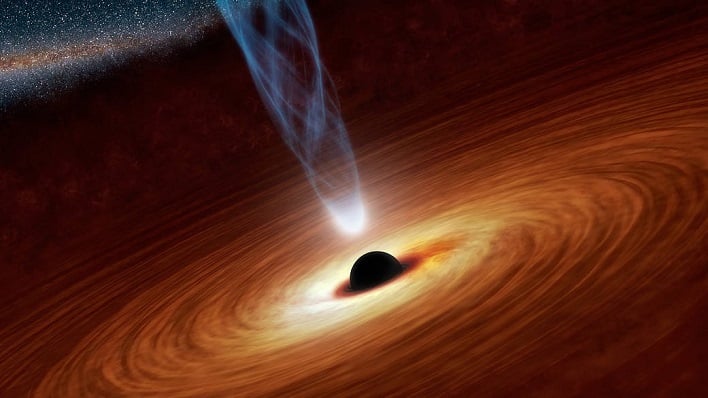Astronomers In Awe As Black Holes Emit A Flare Of Light Brighter Than A Trillion Suns

Galaxy OJ287 lies in the direction of the constellation Cancer at approximately 5 billion light-years from Earth. It has been a focus of study by astronomers from the University of Turku since 1888, where astronomer Aimo Sillanpaa and his associates detected a prominent pattern in its emission that has two cycles, one of around 12 years and a longer one of about 55 years. The team of astronomers suggested that it was the result of the orbital motion of two black holes near one another, with the shorter cycle being the orbital cycle and the longest being the result of the slow evolution of the orientation of the orbit.
In a press release, the team remarked, "The orbital motion is revealed by a series of flares which arise when the secondary black hole plunges regularly through the accretion disk of the primary black hole at speeds that are a fraction slower than the speed of light."
It is this "plunging" of the secondary black hole that heats the disk material and causes the hot gas to release as expanding bubbles. While these extremely hot bubbles cool over a period of months they emit a blue flash, which the team discovered in early 2022.
"The total number of predicted flares now number 26, and nearly all of them have been observed," remarked Professor Achamveedu Gopakumar from the Tata Institute of Fundamental Research in Mumbai, India. He added, "The bigger black hole in this pair weighs more than 18 billion times the mass of our Sun while the companion is roughly 100 times lighter and their orbit is oblong, not circular."
Professor Mauri Valtonen, the lead author of the research paper, explained that even with all the known observations, astronomers had not been able to detect the pair separately, as they merged to a single point in a telescope. Then, during observational campaigns in 2021/2022 of galaxy OJ287 researchers were able to detect the secondary black hole plunging through the accretion disk for the first time ever, along with the signals from the smaller black hole itself.
Earlier predictions stated that during the time the secondary black hole plunged through the accretion disk it would produce a blue flash immediately after the impact. That blue flash was observed by Martin Jelinek and associates, of the Czech Technical University and Astronomical Institute of Czechia, within days of the predicted time.
The exciting observation also yielded two more surprises, detected by Staszek Zola from the Jagiellonian University of Cracow, Poland. The first was a big flare that produced 100 times more light than an entire galaxy and lasted only one day. The second came from gamma rays, with the largest gamma-ray flare in OJ287 in six years happening just as the smaller black hole plunged through the gas disk of the primary black hole.
Valtonen asked, "So what about the one-day burst, why have we not seen it before?" He went on to explain, "OJ287 has been recorded in photographs since 1888 and has been intensively followed since 1970. It turns out that we have simply just had bad luck. Nobody observed OJ287 exactly on those nights when it did its one-night stunt. And without the intense monitoring by Zola's group, we would have missed it this time as well."


